Green is the most common color in parrots. However, parrots don’t naturally produce green pigments, rather there is some trickery of light scattering involved.
According to Emu – Austral Ornithology, green coloration in parrots is achieved through a combination of pigments and feather nanostructures.
Beyond aesthetics, the reason why many parrots are green is thought to be for camouflage in their natural surroundings. Green plumage helps them blend in with the greenery, making it easier to hide from potential threats. Let’s look at the wide variety of green parrot species in the wild:
Quick Navigation
Types Of Green Parrots
Here are 25 green parrot species:
Amazon Parrots
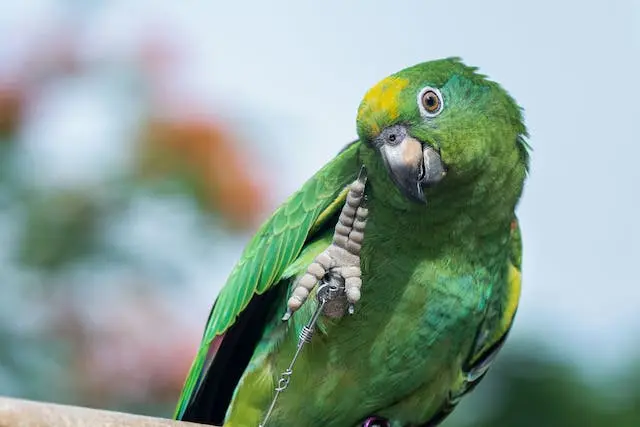
All parrots in the Amazon genus have primarily green plumage with patches of other colors on their faces and foreheads. They are usually medium-sized parrots, but not always appropriate for an apartment setting.
Amazon parrots are one of the most popular parrots as pets and species like the blue-fronted amazons and yellow-naped amazon are known for their intelligence and talking ability.
There are around 30 species in the Amazon parrot family and each of them has a different temperament and personality. So it is important to do your research on the types of Amazon parrots individually before you decide to get one.
Indian Ringneck Parakeets
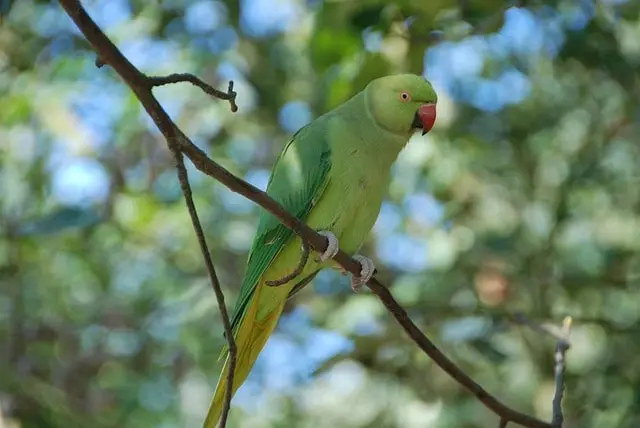
The Indian Ringneck Parakeet showcases brilliant green plumage and the characteristic neck ring on the males. They are an intelligent bird species native to the Indian subcontinent and parts of Africa. Among other parakeets, they are considered one of the better talkers.
Indian Ringnecks can learn an extensive vocabulary and often learn to mimic sounds they hear on a daily basis. In addition to their predominantly green color, mutations in captivity have produced a variety of other color variations, including blue, yellow, and albino. Their friendly and outgoing personality have made them popular companion parrots.
Alexandrine Parakeets
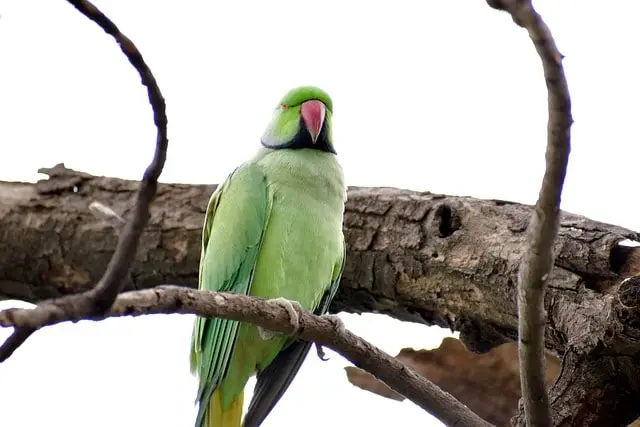
Named after Alexander the Great, Alexandrine Parakeets are medium-sized birds originating in southeast Asia. They are close cousins of the Ringneck parakeets and have similar green plumage and bright red beaks.
Like their cousins, Alexandrine parakeets are talkative and intelligent. They like to vocalize frequently and are always active in their cages, performing acrobatics and other moves. They generally do fine in cages, but because of their highly social nature, they should be given plenty of out-of-cage time.
Plum-Headed Parakeet

Plum-headed parakeets are fascinating birds with stunning feather coloration. Plum-headed parakeets are mainly green parrots with different shades of green on their wings and bodies. What makes them stand out is their violet-colored head feathers.
These parrots are sexually dimorphic and can be distinguished based on the color of their head. Males have purplish-red heads with a black ring around their necks, while females have blueish-purple head feathers without the black neck stripe.
Plum-headed parakeets are shy birds and do not easily trust people. But once they are able to trust their owners, they can be quite social. They are also very quiet and less demanding parrots.
Quaker Parrots
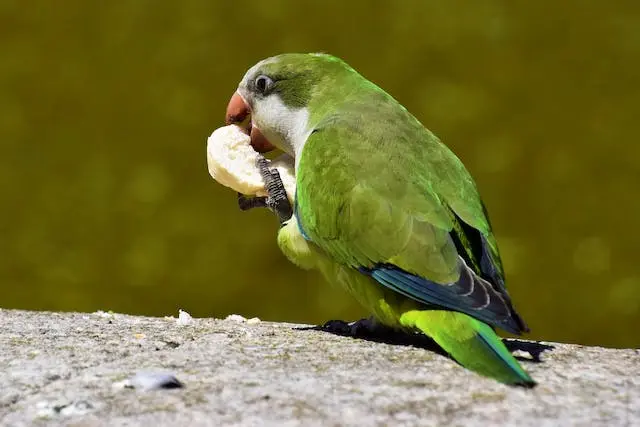
Quaker parrots, also known as monk parakeets, are small, green parrots. They have mostly green bodies with gray coloration on their faces, crowns, breasts, and abdomens. These parrots are native to South America, and primarily found in parts of Argentina, Bolivia, Brazil, and Paraguay.
Quaker Parrots thrive on interactive play and mental stimulation and can get depressed when they don’t get enough of it. That being said, they make friendly and entertaining companions. It is unfortunate that a number of States have banned Quaker parrots as pets.
Senegal Parrots
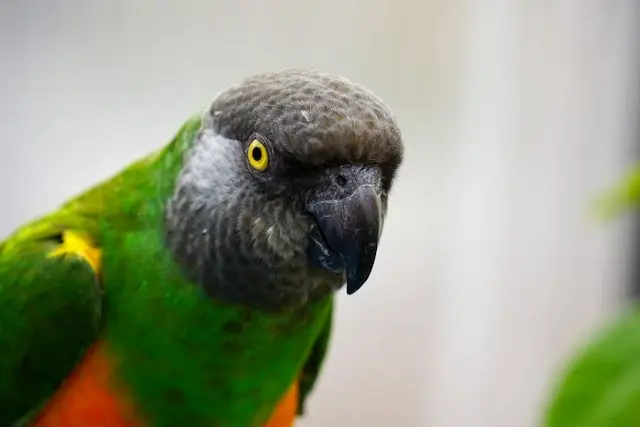
Senegal parrots are not as brightly colored as some of the other parrots, but their darker hues give them an impressive look. They have an entirely grey head, dark green on the back and wings, and yellow abdomen. The green on their chest forms a V-shape, which looks like a vest.
Senegal parrots naturally have an intense and cold look, but their personality is quite the opposite.
They have a calm temperament and are recognized for being easy-going. They are also small in size, which means they don’t require a lot of space.
Budgerigars
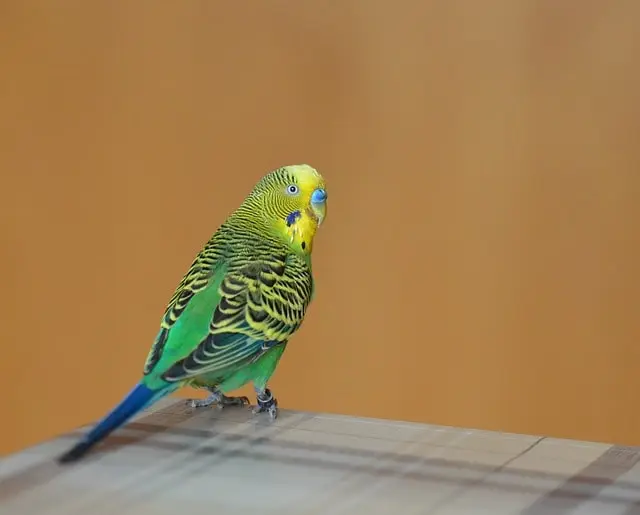
Budgerigars are the most popularly kept parakeets around the world. Their plumage colors primarily include yellow and green with black scalloped markings on their wings, back, and nape.
Budgerigars are not too loud but they can be noisy. They also have impressive vocal abilities and can mimic different sounds and learn words. They are affectionate and relatively easy to care for, which is probably the reason why they are popular as pets.
Superb Parrot
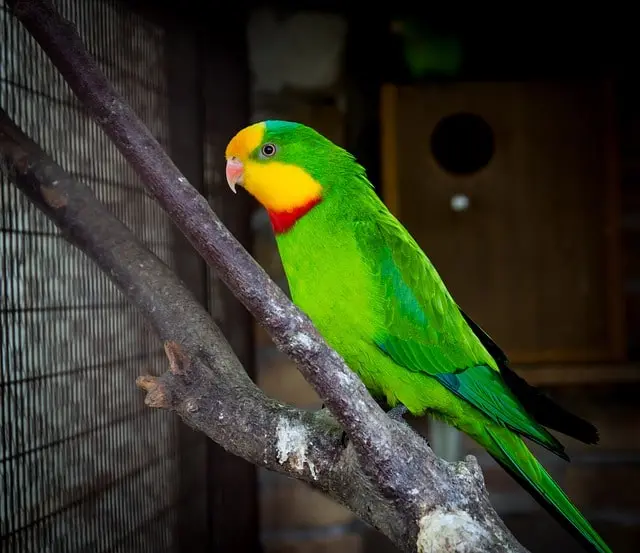
The Superb Parrot, also known as the green leek parrot is a striking green parrot native to south-eastern Australia. They have a light green body with yellow patches on the face and throat and a bright red band on the upper chest.
Superb Parrots are characterful and funny birds. They love to socialize and bond deeply with their owners. They are skilled talkers and can learn words, sounds, and even long phrases.
The Superb Parrot is a medium-sized parrot, measuring around 37–42 centimeters in length. In addition to that it also has a long pointed tail, which means it requires a sizable enclosure to move freely.
Lovebirds
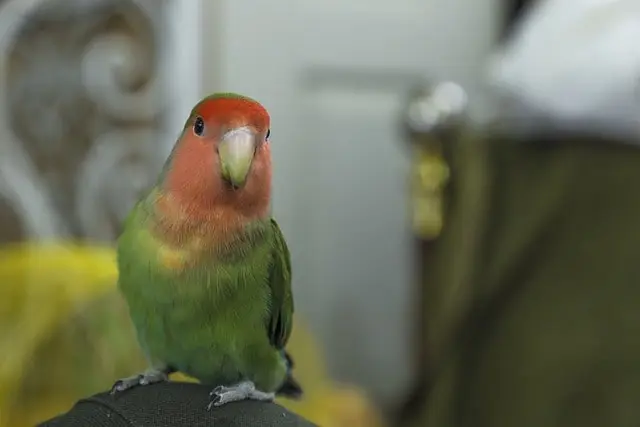
Lovebirds come in a variety of colors, but most of their species are primarily green. Lovebirds get their names for being highly social birds that make strong bonds with their mates.
In captivity, these birds thrive on companionship forming bonds with their owners. However, if another mate is introduced to them, the lovebird will focus its attention on the new bird, ignoring all humans.
Lovebirds might be small in size, but they are feisty, outgoing, and inquisitive birds. As single pets, they require plenty of attention from their owners in order to stay mentally stimulated.
Male Eclectus Parrots
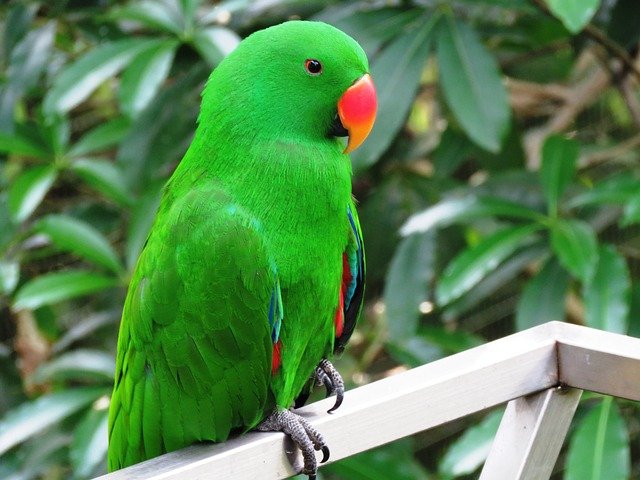
The male Eclectus is a brilliantly colored green parrot. It has distinctive emerald green feathers, with vivid red and blue markings under the wings and a bright orange beak.
Eclectus parrots exhibit the most obvious sexual dimorphism of any parrot species. The difference between the two genders of eclectus parrots is so striking that for a long time, aviculturists believed that they were two different species.
Female Eclectus parrots are predominantly bright red with deep purple markings on their abdomen and wings.
Eclectus parrots are tranquil and gentle birds that do well in a family setting. They are one of the few frugivore birds and their diet includes mainly fruits and vegetables.
Nanday Conures
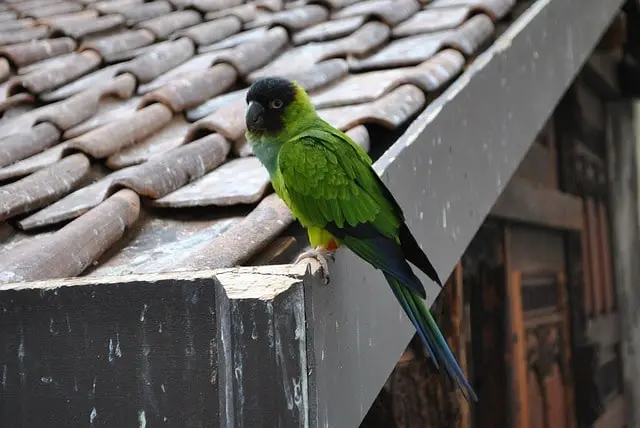
Nanday conures are splashed in different shades of green all over their body. They have a bluish-green upper chest, a pale green belly, and darker hues of green on their wings and back.
They also have a distinctive black mask and beak, which is why they are also referred to as Black-Hooded Parakeet.
They are talented talkers and eager to expand their vocabulary. They are also playful birds that can be taught many tricks and make an entertaining companion. However, nanday conures are among the most vocal and loud conures, which makes them unsuitable for beginners.
Green-Cheeked Conure
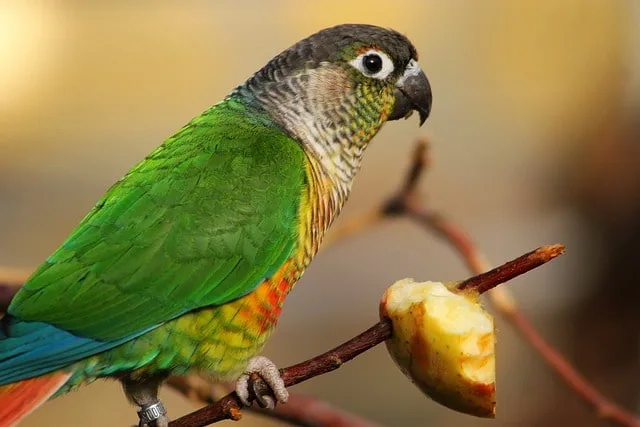
Green-cheeked conures are characterized by their predominantly green plumage, with a washed grey crown, red tails, and distinctive dark scalloping on their feathers.
These conures are prized for their intelligence and ability to mimic. But that’s not all, Green cheek conures are funny and mischievous. They are full of tricks and have a knack for hanging upside. However, they need consistent interaction with people and adequate time out of their cage.
Maroon-Bellied Conures
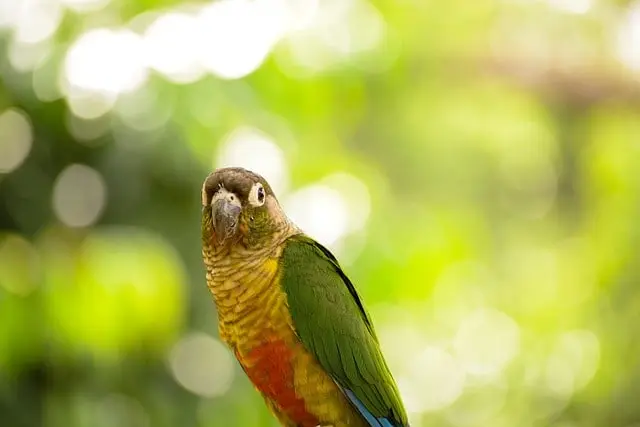
Maroon-bellied conures have mostly the same colors as Green-Cheeked Conures with a complimentary patch of maroon feathers on their abdomen. However, the green on the Maroon-Bellied Conures appears more muted and pale.
Maroon-bellied conures make good pet birds and are loving and friendly. But compared to other conures, they are more reserved. With time spent on training and interaction, they can start to open up and form a bond.
Peach-Fronted Conure
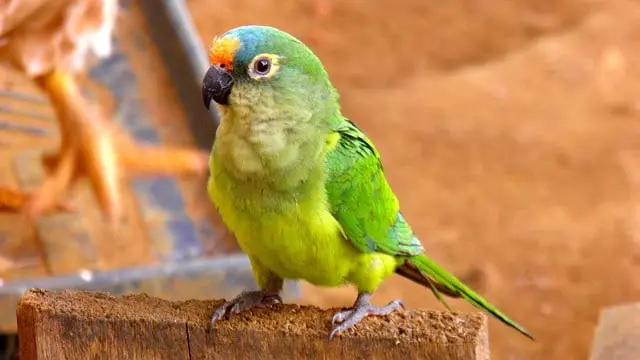
The Peach-fronted Conure is native to South America, particularly found in Brazil, Paraguay, and Argentina. They have brilliant tropical green feathers and a peach-colored crowned.
They are often confused with the orange-fronted conure, which is a similar-looking parrot. They are tiny parrots, but big on personality. Peach Fronted Conure is a fun bird to have for any parrot enthusiast.
There’s just so much to them, all in a tiny package. These parrots are playful, cuddly, and talkative, overall making them great companions.
Military Macaws

The Military Macaw is a large parrot named for its military-like colors, resembling a parade uniform. They have an olive green plumage, with blue accents on their flight feathers, and a red upper tail. They also have a red patch on the front of their heads.
They are smart birds with an innate desire to socialize. They are expressive and talkative and can amass a considerable vocabulary. Being large macaws, they require big and wide enclosures to live.
Red-Fronted Macaws
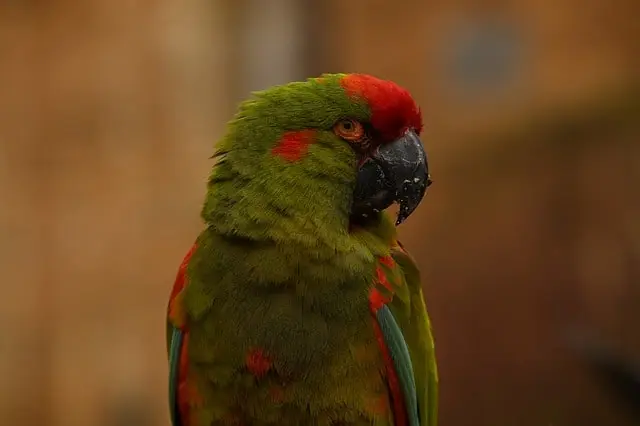
Red-fronted macaws have very similar plumage colors to the Military Macaws, but they are two different species.
They are mostly green, with blue flight feathers and red accents on the front of their head. However, the green hues of Red-Fronted Macaws are more pale in comparison.
Red-fronted macaws are noted among the smaller species of macaws. However, they are still quite big and measure between 21.5–23.5 inches. These parrots are extroverted and lively. They are not noisy birds, but they can have loud spurts from time to time.
Severe Macaw
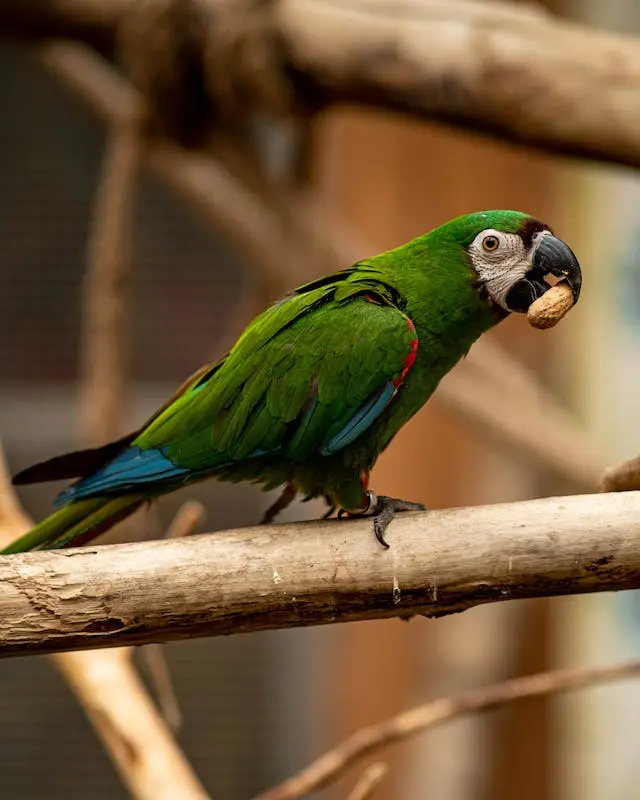
A charming-looking parrot, the severe macaw is a mini macaw originating in parts of originating from South America. They have mostly dark green feathers with chestnut-colored patches on their forehead.
Their plumage is ornamented with other colors, including a patch of red under their wings and some blue on the edge of their wings.
The severe macaw is a fun-loving and curious parrot that’s a good choice for bird enthusiasts. But it must be noted that they are one-person birds and will get attached to their caretakers who spend the most time with them.
Great Green Macaws
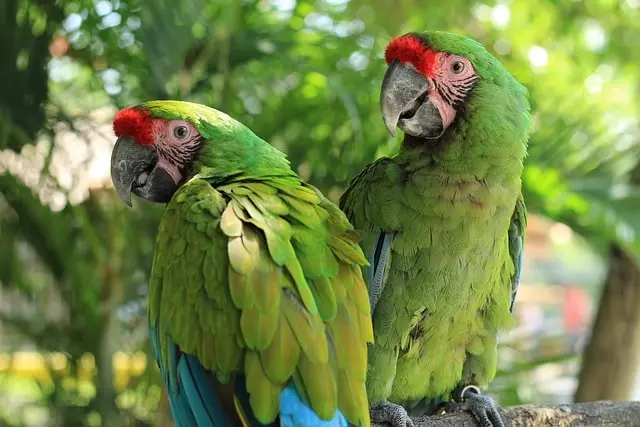
The Great Green Macaw is a stocky parrot and second the heaviest macaw species. These macaws are on average 33.5–35.5 inches in length and 1.3 kg in weight. It has cool green plumage, vibrant red patches on its forehead, and a blue color on its outer wings.
Sadly, the Great Green Macaw faces significant threats due to habitat loss and illegal capture by the pet trade and is listed as endangered. Great Green Macaws are gregarious birds and need to stay busy for stimulation either through their playtime with owners or gnawing on chew toys.
Hahn’s Macaw

The Hahn’s macaws are the smallest macaw species measuring 12–14 inches. have bright blue feathers and long tails. They are recognized by their compact size beautiful green color vibrant red feathers on their forehead and shoulders.
Hahn’s Macaws are small but carry a bold and boisterous personality. They have impressive mimicking ability, however, they are loud screamers and are known for their grating voice. They are very active during the day and their size makes them easy to handle, though they still require a roomy enclosure.
Pacific Parrotlets
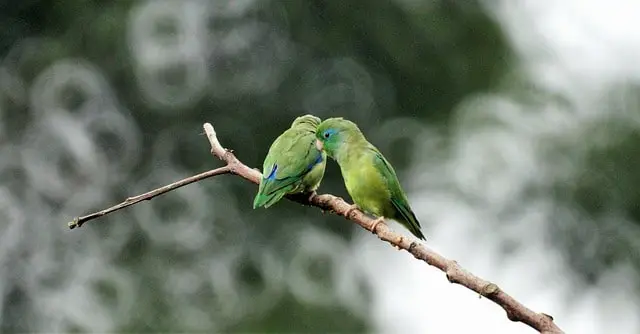
The Pacific parrotlet is an adorable small-sized parrot originating from Ecuador and Peru in South America. Pacific Parrotlets boast a vibrant all-green plumage. However, captive breeding has brought about certain variations in their primary colors.
Don’t go by their size, these feisty parrots are outgoing and highly vocal. They make chirps and other vocalizations but their mimicking skills and quality of voice aren’t that sharp. Nonetheless, they make fun companions and are easy to take care of.
Spectacled Parrotlets
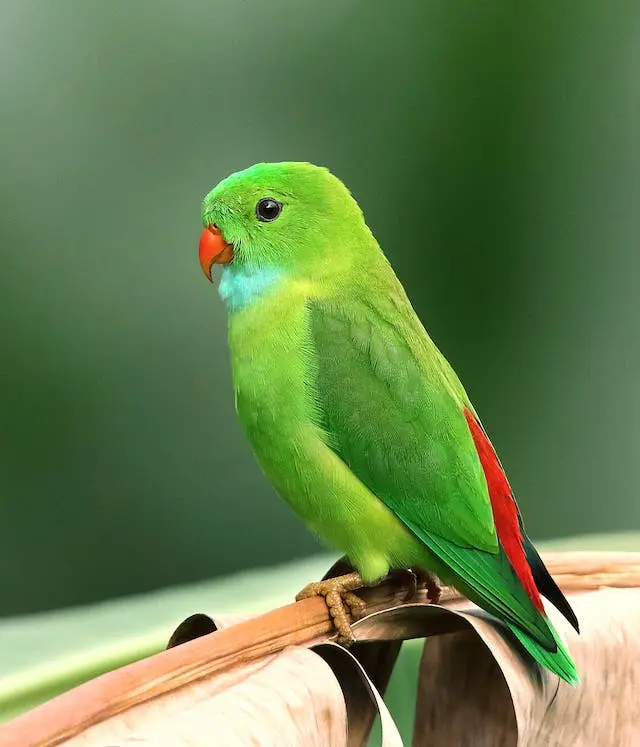
The Spectacled Parrotlet is a small parrot native to eastern Panama, Colombia, and Venezuela. They are sexually dimorphic parrots, meaning the males and females can be told apart based on their physical appearance.
Both genders have light green feathers. The males have a dark blue patch underneath their wings and a bright blue ring around each eye. The males also have splashes of blue on their primary and secondary coverts. On the other hand, females have a bright emerald ring and no blue markings.
When tamed, these birds make wonderful cuddly pets. They are known for being mischievous and are full of character. Like most parrotlets, they can live up to 20 years or more in captivity.
Kakariki Parrot
The Kakariki is a small parrot native to New Zealand. Kakariki parrots come in a variety of colors, but their traditional colors in the wild are bright green or cinnamon green. They also have a red-colored patch on their forehead, which gives them their second name – Red-crowned parakeet.
In the United States, the red-fronted kakariki is most the common type of kakariki kept as pets. Kakariris are quite active in their cage, hanging and climbing to keep themselves engaged. They are fairly chirpy throughout the day, but not too loud. Because of their destructive nature, they need a consistent supply of chew toys otherwise they may go after the furniture.
Musk Lorikeet
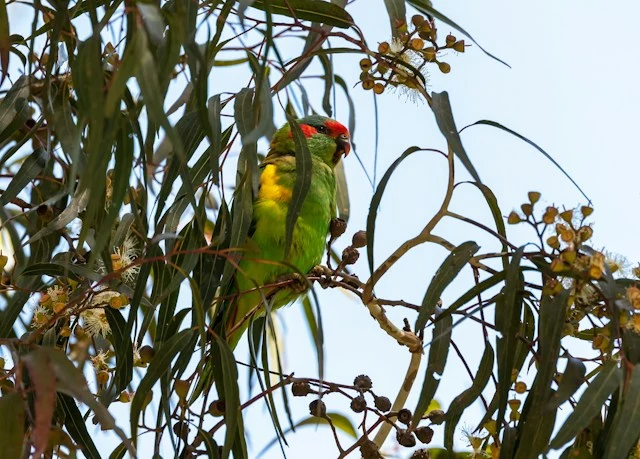
The musk lorikeet is named for the musky scent it emits. It is a small parrot native to south-eastern Australia. The musk lorikeet features a predominantly green body with red cheeks, forehead, and yellow bands on the shoulder.
These parrots are energetic and goofy, with a bold character. They are avid whilters and easily pick up other sounds from the environment such as doorbell rings or phone ringtones. Like all lorikeets, the majority of their diet includes fresh fruits and vegetables as they are natural frugivores.
Little Lorikeets
The little lorikeet has a red face, and light brown nape, and the rest of its body is comprised of three different shades of green.
Little lorikeets are fond of training sessions and cuddles and can make good pets for people who are willing to dedicate a few hours to them daily. Because of their intelligence and entertaining personalities, these birds are gaining popularity.
Scaly-Breasted Lorikeets

Aptly named, the Scaly-breasted Lorikeet, these parrots are distinguished by the scaly pattern on their breast feathers, which contrasts with their predominantly green plumage.
Scaly-breasted Lorikeets are native to Australia and are often observed as part of noisy flocks in the wild. They are not as noisy in captivity, but they are playful and outgoing.







